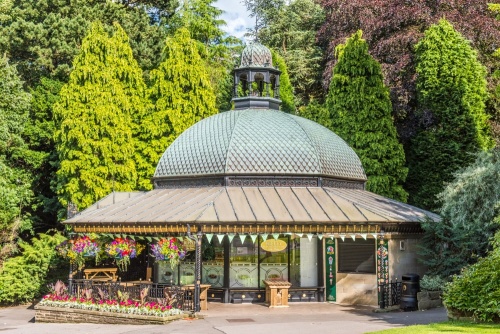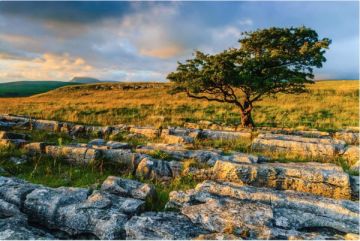
Valley Gardens is a historic Victorian 17-acre public park in elegant Low Harrogate, boasting parkland, woodland walks, and flower gardens. Valley Gardens is famous for the extraordinarily large number of mineral springs that come to the surface here. These mineral springs made Harrogate into a fashionable spa town.
Valley Gardens is a wonderful reminder of Harrogate's heyday as a spa town. The Gardens are dotted with restored wellheads and elegant Victorian Gothic pump rooms, with colourful garden areas and a cafe housed in the 1895 Magnesia Well New Pump Room.

Bogs Field
At the heart of Valley Gardens is Bogs Field, where 36 of Harrogate's 88 mineral springs come to the surface. That makes Bogs Field the location with the highest number of unique mineral springs than any other place in the world. Note the word 'unique' in the last sentence. Each of the 36 wells that emerge here is unique in its mineral composition. No two are the same.
Perhaps just as remarkable is that none of the waters here ever existed as rain water. For 20,000 these waters have flowed deep under the earth's crust before rising to the surface through vertical vents, or shafts. The springs here were known as early as the 15th century when they were dubbed 'Sour Springs'.
The springs in Bogs Field were first developed commercially in the Victorian period. Water was pumped underground to the Royal Pump Room opposite the park entrance and to the Royal Bath Hospital and the Baths in Low Harrogate.
Many of the wells are located between the bandstand and the paddling pool in a large area bounded by an oval set of paths.

Old Magnesia Well
This is one of the oldest wells in Harrogate. It was first identified by Dr Short in his 1652 book 'The Yorkshire Spaw' (yes, that is the correct title spelling). Dr Short recommended the Magnesia Well water as a strong diuretic. The water is mildly sulphurous and was chemically analysed in 1867 by Dr Sheridan Muspratt.
Pure Chalybeate Well
Known for its remarkable pure water with exceptionally low salt content, this well was once used to treat anaemic patients, along with the Tewit Well and St john's Well. The well water was pumped to the Royal Baths where it was aerated. The water is protected by a Victorian wellhead restored by the Harrogate Civic Society in 1999.

History
The gardens can be said to have begun in 1841 when the Harrogate Improvement Act approved a footpath through Bogs Feld, providing access to the mineral springs. Then in 1858, the Magnesia Well Pump Room was erected.
In 1886 the Borough Council bought the land between Bogs Field and the Royal Pump Room. They launched a competition with a prize of £15 to create a landscape design for a 'Public Pleasure Grounds' along the existing footpath. The Council eventually decided not to implement any of the designs but instead asked the Borough Engineer to come up with a plan implementing the best bits of each submission.
Valley Gardens was developed as an outdoor recreation area for visitors to the spa, a place to enhance the health benefits of 'taking the waters' with gentle exercise. It also provided access to the 36 wells that arise here. Paths led beside a boating lake, with a bandstand for outdoor concerts and a tea room for refreshments. Valley Gardens became a popular place for socialising; a place to see and be seen.

The Sun Pavilion and Colonnades came in 1933 and were intended as the first phase of a covered walkway linking the Royal Pump Room and the Royal Bath Hospital.
After the popularity of the spa declined in the 20th century the gardens focussed more on horticulture, with colourful flower displays and special events like the Northern Horticultural Society’s Spring Flower Show. Rare trees were planted along with two rock gardens (now the scree garden). The New Zealand Garden opened in 1954. Later additions include a Japanese Garden and Peat Garden.
The Harrogate Link, and extension of the Dales Way long-distance footpath, begins in Valley Gardens. The Harrogate Link runs the length of the Gardens and connects central Harrogate to RHS Harlow Carr Gardens on the outskirts of the town.
Near the Valley Gardens entrance is a plaque erected by the officers and nurses of the 116th General Hospital of the US Army, which was based in Harrogate from 28 July 1944 to 11 May 1945.


Getting There
Valley Gardens is bounded by Valley Drive and Cornwall Road. The main entrance to Valley Gardens is directly opposite the Royal Pump Room, at the junction of Cornwall Road, Valley Drive, Crescent Road, and Royal Parade. It is extremely easy to reach from the historic heart of Harrogate. There is no dedicated parking but there are several paid parking areas within a short walk of the town centre.
About Valley Gardens, Harrogate
Address: Valley Drive,
Harrogate,
Yorkshire,
England, HG1 2SZ
Attraction Type: Garden
Location: At the junction of Cornwall Road, Valley Drive and Royal Parade directly opposite the Royal Pump Room Museum. No dedicated parking but there are several pay and display parking areas nearby.
Website: Valley Gardens, Harrogate
Location
map
OS: SE296552
Photo Credit: David Ross and Britain Express
HERITAGE
 We've 'tagged' this attraction information to help you find related historic attractions and learn more about major time periods mentioned.
We've 'tagged' this attraction information to help you find related historic attractions and learn more about major time periods mentioned.
Historic Time Periods:
Find other attractions tagged with:
12th century (Time Period) - 15th century (Time Period) - 16th century (Time Period) - Norman (Architecture) - Pevsner (Person) - Victorian (Time Period) - Victorian Gothic (Architecture) -
NEARBY HISTORIC ATTRACTIONS
Heritage Rated from 1- 5 (low to exceptional) on historic interest
Royal Pump Room Museum, Harrogate - 0.1 miles (Museum) ![]()
Mercer Art Gallery - 0.2 miles (Museum) ![]()
Harrogate, St Wilfrid's Church - 0.2 miles (Historic Church) ![]()
Harrogate, St Peter's Church - 0.4 miles (Historic Church) ![]()
Tewit Well, Harrogate - 0.8 miles (Historic Building) ![]()
RHS Garden Harlow Carr - 1.2 miles (Garden) ![]()
Mother Shipton's Cave - 3.2 miles (Countryside) ![]()
Ripley, All Saints Church - 3.4 miles (Historic Church) ![]()
Nearest Holiday Cottages to Valley Gardens, Harrogate:
More self catering near Valley Gardens, Harrogate












